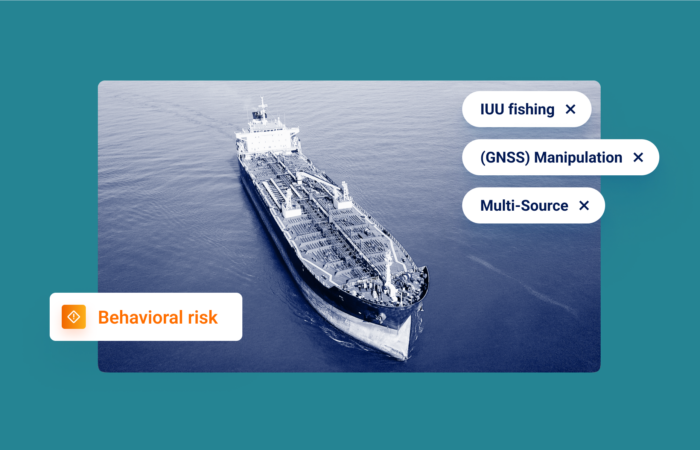What’s inside?
Illegal, unreported, and unregulated (IUU) fishing is both urgent and complex, which is causing some entities to miss an important part of a successful environmental, social, and corporate governance (ESG) strategy.
For shipping stakeholders and business owners, monitoring this growing trend is essential for ensuring their business is not at risk of being sanctioned, or involved with any IUU fishing or supporting fleets.
This goes beyond sanctions or other risks, and is also an ethical issue. Firstly, IUU is one of the greatest threats to marine ecosystems and fish-based economies. Secondly, IUU fishing vessels are often associated with forced labor and other illegal activities.
Stanford’s Center for Ocean Solutions states, “Fishing vessels engaged in IUU fishing often engage in labor abuses including exploitation, forced labor, debt bondage, human trafficking, and modern slavery. Crews can be trapped at sea for months or years at a time, working in grueling conditions and sometimes facing wanton brutality. Wages are withheld or simply never paid.”
Let’s take a closer look to better understand how this ecosystem works and highlight a piece of ESG strategy that many are currently missing…
Mapping out the different zones
Exclusive Economic Zones (EEZs) are designated zones at sea in which sovereign states have special rights regarding the exploration and use of marine resources. Stretching from the outer limit of the territorial sea out to 200 nautical miles from the state’s coast, “they are perhaps the largest property rights institutions in the world, covering about 39% of the ocean’s surface and accounting for more than 95% of global marine fish catch,” according to Global Fishing Watch. For a legal fishing vessel to enter a foreign EEZ and fish, a permit is required.
What are hot zones?
Hot zones are activity clusters for long-distance fishing fleets that were identified by Windward’s behavioral analysis. Most global hot zones are located just outside EEZ boundaries.

IUU long-distance fishing and supporting fleets
The White House Memorandum on Combating Illegal, Unreported, and Unregulated Fishing and Associated Labor Abuses states, “Distant water fishing vessels, which engage in industrial-scale fishing operations on the high seas and in waters under other states’ jurisdictions, can be significant perpetrators of IUU fishing and related harmful fishing practices.”
IUU fishing mostly occurs on the border of foreign EEZs in fishing hot zones. These IUU fishing vessels stay on the border of the EEZ and illegally enter to fish by disabling their AIS and “going dark,” so that they are untraceable. “Notably, more than 96% of EEZ-adjacent disabling events occurred next to foreign EEZs. However, many global fishing hot spots are located just outside EEZ boundaries; thus, this pattern may be partially explained by the increased levels of fishing activity in these areas.”
Windward has identified a behavioral trend: these IUU long-distance fishing fleets turn to reefers and oil bunkering tankers, known as support fleets, to aid and enable prolonged, seasonally-independent operations. According to Windward’s insights, of +2,000 vessels that were actively fishing in the Pacific during September 2022, 50% were involved in ship-to-ship (STS) operations in the open sea.
This means 50% of fishing vessels get the supplies they need and discharge their catch without ever having to call port, or formally report on their activities. Approximately 60% of recorded meetings were with reefers, and the rest (40%) involved oil bunkering vessels. The first is mainly used to get the catch back to land, while the latter keeps them fueled while at sea. “The disabling of AIS devices can obscure illegal activities, such as unauthorized fishing activity in EEZs and unauthorized transshipments, in which catch from fishing vessels is off-loaded to refrigerated cargo vessels at sea.”
These IUU long-distance fishing vessels often aren’t seen for months in ports; according to Windward’s insights, out of the +2,000 vessels that were operating in the Pacific during September 2022, 38% were not seen in any port for at least six months, and 23% were not seen in any port for over a year.
This isn’t just about IUU vessels fishing illegally, but an ecosystem that has been created and continues to grow. Forced labor, human trafficking, and human rights abuses are often associated with these IUU long-distance vessels, and the crews on board don’t see land for months. It is crucial that businesses take responsibility and ensure that they have an “ethical supply chain,” preventing the exploitation of workers and other illegal activities.
Is your fishing supply chain ethical?
Supporting fleets often sail under flags of convenience and are insured just like any other commercial vessel in the world fleet, exposing their funding and insuring entities to regulatory, financial, and reputational risk. It is crucial for shipping stakeholders and companies to closely monitor fishing and support fleets with a clear overview of other actors involved across the entire supply chain.
Not all maritime organizations have factored IUU in the ESG equation. A comprehensive maritime ESG policy should include an extended due diligence process, mitigating risk and ensuring you know who you’re doing business with. Companies are entrusted with having an “ethical supply chain” and could be exposed to sanctions if irregularities arise around this topic following an audit. But, this goes far beyond sanctions compliance and is an ethical responsibility to ensure a sustainable future for all.


